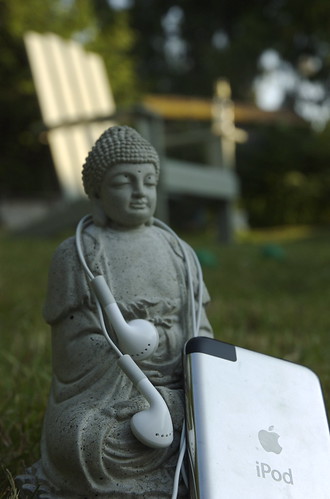He's in the bindi on my forehead.
He's in the sleepiness of my lashes."
-from the song "Dola Re Dola," Devdas

Fig.1 Oooooh shiny
'Twas a hot summer day in 2006 when my best friend Connie and I went to Islands of Adventure in Orlando. As is typical whenever we go to theme parks together, we were feeling adventurous and decided to work up the courage to hit the rollercoasters. Having grown up in central Florida, we had our share of hours on various thrill rides at Busch Gardens, Sea World, Disney, EPCOT, Animal Kingdom, and Universal Studios, but had never really taken advantage of the superior rides at IOA. Once we survived (and loved!) the Dueling Dragons, we were gung-ho for The Hulk and actually returned to the Dragons for a second time.
Somewhere in there, though, we stopped in at one of the Lost Civilization Island’s fantasy bazaar (now refurbished into Harry Potter World, or whatever), where all the shops are made up to look like they were lifted straight from Aladdin. Of course, I found the tent hawking the overpriced bellydancing supplies and fawned over the jingly belts and earrings and costumes I would never buy outside of a Renaissance Faire (much better deals). But I did pick up a small packet of multicolored bindis and promptly shared them with Connie. I wore a pink one and she wore blue, to coordinate with our t-shirt colors. We felt extra pretty walking around all day with our foreheads so adorned, but little did I know this one impulse purchase would lead to a new personal fashion habit that continues to this day.
A few weeks later, I brought the same set of bindis with me on a week-long family trip to Key West. Key West, being Key West, is the provenance of all things kitsch and casual in my beloved state of Florida. Art shops, pirate jewelry sellers, pizza parlours, creperies, Margaritaville, Sloppy Joe’s, the Hog’s Breath Saloon—all bathed in the colors of the setting sun and neon signs. Almost everything we ate was seafood or was impregnated with key lime the same way everything on Dune is impregnated with Spice. It’s warm and inviting, but small and colorful and comforting, and you get the feeling that after dark, anything goes on Duval Street. There are kitschy restaurant bars every 50 feet, trinket shops in between, and streetside kiosks offering henna tattoos. It was just the kind of place I could wear my bindis, buy a sari (which I did), and walk around wearing both without feeling out of place.
When I got home, the bindis stuck, but I soon realized that they have an expiration date. The glue doesn’t hold out for long, and they get cruddy after a few weeks of constant use.
"Bindi" means “dot” in Sanskrit. Originally, they signified age, marriage, and/or religious affiliation, depending on who was wearing one (yes, even men wear the mark of sindoor on holy occasions). Traditional ones were simply crimson or yellow vermillion powder applied to the forehead during temple ceremonies or everyday home shrine puja offerings. The placement is meant to represent the ajna chakra, known as the center of insight and wisdom. The color red also represents the femenine power of the goddesses Sati and Parvati, and women who wear this tilak ("mark") will receive their blessings.
After years of watching Hindi movies (I promise a post on that soon!), I had seen every shape and size of bindi worn by hot Bollywood actresses, and it was just a matter of time before I decided that I wanted a piece of that action. Sometimes they wore them, sometimes they didn’t, and sometimes they wore big gaudy ones for special occasions.

Fig.4 Aishvarya Rai pimpin' her bindi in the movie Devdas
South Asian women in modern times treat the bindi as any other piece of jewelry or fashion accessory, no matter what their social status or association. As a result, they now come in an eye-popping array of styles, as I soon discovered when I went online to search for an internet site that sold them. Bindis come in every color to match your outfit and every size and shape to suit your occasion. They come plain or encrusted with crystals, pearls, and metallic accents.
The first site I ordered from sent me a small slightly battered package a few weeks later. It was a box wrapped in white cloth, sewed up with thread, my address was written in blue marker on the top, and it was slapped with a customs declaration certificate from Vastrapur Ahmedabad, India. It certainly looked like it had come from halfway around the world. Pretty wild, right?

Fig.5 We're not in Delhi anymore, Toto
I have since tried other sites as well, and one, Visionsofindia.com, hails from California, so my packages come much more quickly. Now, I’ll purchase between eight and ten new little packets of bindis every three months or so, so I get to try new styles all the time. I wear them everyday, every time I go out. It’s as obligatory as earrings or a necklace and I feel naked if I forget to put one on. The websites sell skin-safe bindi glue, but I’ve found that eyelash glue works very well, too. I have quite a collection, and I use the old ones to fancify picture frames or bedazzle some other craft I may be creating.
I’ve been lucky that my employer has no objection to my little quirk. Sometimes I think that they think it’s a strictly religious thing, and what with all the Islamic hijab-related school uniform debates in the news, they don’t want to be sued for discrimination. They don’t care about my tiny gold nose stud either, which is even more innocuous than the bindis, but complements my overall recherché Indian fashion so well that neither register as especially unusual.
Early on, my good friends got used to it immediately, calling it “such a Caity thing.” Given that they’ve witnessed my long history of hair and jewelry-related personal fashion kicks through the years, bindi-wearing was an organic development.

Fig.6 Another trademark "Caity Thing"
The most frequent inquiry from co-workers or random people standing in line at the cash register is about whether or not it’s a piercing, and I have to explain that it’s really just a snazzy sticker. I also get asked whether it “means something,” and I say that for me, it’s just something pretty, and what girl doesn’t like a little something extra sparkly to wear? I also clarify the ancient versus modern interpretation of its significance, and I feel happy that I’ve injected a bit of world culture into someone’s day.
When I’m out in places full of people who don’t work with me everyday and are incidentally immune to the oddity of bindis, I get glances and outright stares, especially from little kids who point tug at their mother’s shirt and poke at their own foreheads to communicate their absolute amazement at my facial adornment. I’ve even gotten a few bright elementary school children who correctly identify it as an “Indian” thing. They love it, and I wouldn’t be surprised to see them start running around with Dora The Explorer stick-on earrings worn on their ajna chakras.
At the end of the day, I remind myself that the Buddha wore bindis, and protecting the wisdom chakra with a bindi never hurts. The last thing I do after getting ready for the day is choose a bindi to wear, and in that way, what began as a fashion statement has evolved into religious ritual for me. The bindi does mean something to me. It’s a constant expression of my faith in beauty, wisdom, and individuality. With that definition behind the bindi, I don’t foresee my ever growing tired of it.
Fig.7 A girl has so many choices...















